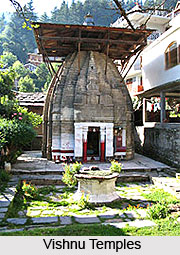 There are two prominent Vishnu Temples in Naggar. One is on the way to the Naggar village on the right side of the road. This Vishnu temple is a humble pyramid-shaped structure and carries substantial archaeological importance. The festival `Ganer` is observed here.
There are two prominent Vishnu Temples in Naggar. One is on the way to the Naggar village on the right side of the road. This Vishnu temple is a humble pyramid-shaped structure and carries substantial archaeological importance. The festival `Ganer` is observed here.
The second Vishnu Temple is located near the castle on the eastern side, a few steps down the main road towards the Naggar village. This also bears semblance to a pyramid with a slatted roof. A notable point to be counted here is that, there is complete absence of a `mandap` in the front portion of the Vishnu Temple. The idol stands on a plinth (kamalasan) and is a chaturbhuj (an idol with four hands) figure. The platform is itself a stone square measuring a foot high. Petals of kamal (lotus) are exquisitely carved around it.
This article is a stub. You can enrich by adding more information to it. Send your Write Up to content@indianetzone.com











